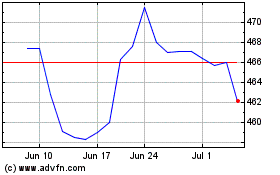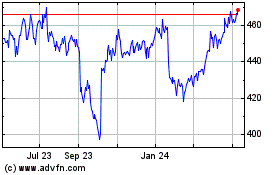U.K. to Boost Spending on Military Equipment
November 22 2015 - 7:30PM
Dow Jones News
By Nicholas Winning
LONDON--Britain will boost its defense-equipment budget by 7% to
GBP178 billion ($270 billion) for the next 10 years, Prime Minister
David Cameron is due to say Monday as he prepares to step up the
case this week for the U.K. to join the U.S. and others in carrying
out airstrikes on Islamic State targets in Syria.
The prime minister is due to set out the U.K. government's
military priorities for the years ahead in two documents, the
National Security Strategy and the Strategic Defense and Security
Review. As part of those plans, Mr. Cameron will also say the
increase in funding for military equipment would go toward a range
of projects including nine new maritime patrol aircraft, extending
the life of the Typhoon jet fighter, and the creation of two new
rapidly deployable brigades by 2025.
Ahead of the release of the two military-strategy documents, the
government also confirmed on Sunday that it planned to buy 138
Lockheed Martin F-35 jet fighters and aims to have 24 in operation
by 2023, although it declined to give cost or other details. The
number is larger and the rollout is sooner than many had
expected.
In an apparent turnaround from the 2010 defense review, in which
the emphasis was on sharp reductions in spending and military
personnel to trim the U.K.'s budget deficit, Mr. Cameron is due to
say in the foreword to this review that Britain's renewed economic
strength means the country can now afford to invest further in
national security.
"This is vital at a time when the threats to our country are
growing. From the rise of ISIL [Islamic State] and greater
instability in the Middle East, to the crisis in Ukraine, the
threat of cyberattacks and the risk of pandemics, the world is more
dangerous and uncertain today than five years ago," he will say,
according to advanced extracts provided by his office.
It remains to be seen if Monday's defense strategy convinces
observers that the U.K. has the muscle to take a significant role
in global affairs. The U.K. government's defense cuts over the last
five years have been so severe that some U.S. officials have raised
concerns that Britain's military capability is being curtailed at a
time of increased global conflict and instability.
Those questions were answered in part in the summer when the
U.K. government committed to meeting the North Atlantic Treaty
Organization target of spending at least 2% of national income on
defense a year. U.K. Treasury Chief George Osborne is due to set
out the government's autumn update on its economic plans and its
outlook for departmental spending on Wednesday.
The government's latest update on military strategy comes amid a
surge in international diplomatic activity to step up the fight
against the Islamic State militant group in the wake of attacks in
Paris that left more than 100 people dead. The United Nations on
Friday unanimously passed a counterterrorism resolution that
authorizes the use of military force against Islamic State and the
related al-Nusra Front.
Mr. Cameron is due to meet French President François Hollande on
Monday morning to discuss counterterrorism cooperation and the
fight against Islamic State. Later in the week, the prime minister
is due to urge the U.K. parliament to approve extending the Royal
Air Force's bombing campaign against Islamic State to Syria from
Iraq where it has been bombing the group for more than a year,
although Mr. Cameron and other senior ministers have said the
government won't hold a vote on the issue until it is confident it
has the support of lawmakers.
The prime minister suffered a stinging parliamentary defeat in
2013 on a proposal for military intervention in Syria following
allegations that President Bashar al-Assad's regime used chemical
weapons on civilians. The opposition Labour Party voted against the
action, but others also voiced concerns that Britain's intervention
was unnecessary or could make matters worse.
Some of those concerns remain, and the issue has been
complicated further by Russia's military intervention in Syria, a
renewed international diplomatic push to end the Syrian civil war,
and a new Labour leader who is set against Western military
intervention in the Middle East. However, Mr. Cameron said last
week that the Paris attacks had strengthened the case for Britain
to join airstrikes in Syria.
The British prime minister has argued that the U.K. faces a
direct and growing threat from Islamic State that it needs to deal
with not just in Iraq, but also in Syria, where the group is based.
While the U.K. is already supporting allies conducting strikes
against Syria by providing intelligence and surveillance, it should
be doing more and shouldn't expect others to carry the risk of
protecting Britain, he has said.
As part of the new military strategy plans to be announced
Monday, Mr. Cameron is due to say the government will extend the
life of Typhoon jet fighter for 10 years to 2040, boosting the
number of squadrons by two to a total of seven with about 12
aircraft each. It will also buy nine new Boeing P8 maritime patrol
aircraft for surveillance, anti-submarine and anti-surface ship
warfare, covering a blind spot in capability since the government
phased out the Nimrod aircraft in 2011.
The prime minister is also slated to announce plans for the
creation of two "Strike Brigades" by 2025, comprising as many as
5,000 men each and including 600 armored vehicles, which will be
able to deploy rapidly.
Stepping up counterterrorism efforts are also set to be a key
theme in the defense reviews, including more funds to boost
manpower at Britain's intelligence agencies and GBP2 billion for
new equipment for special forces. The government confirmed Sunday
that it planned to increase counterterrorism spending by 30% in
real terms over the course of the five-year parliament ending in
2020 to GBP15.1 billion.
Write to Nicholas Winning at nick.winning@wsj.com
(END) Dow Jones Newswires
November 22, 2015 19:15 ET (00:15 GMT)
Copyright (c) 2015 Dow Jones & Company, Inc.
Lockheed Martin (NYSE:LMT)
Historical Stock Chart
From Mar 2024 to Apr 2024

Lockheed Martin (NYSE:LMT)
Historical Stock Chart
From Apr 2023 to Apr 2024
